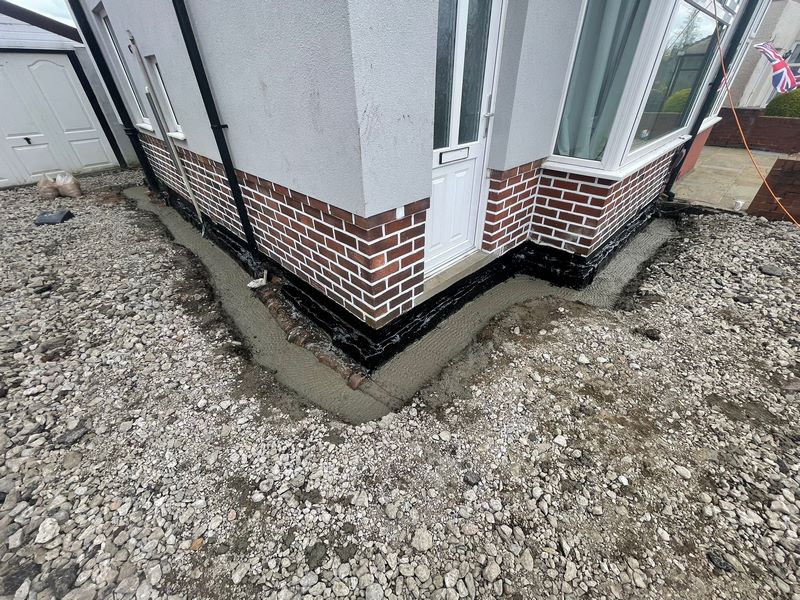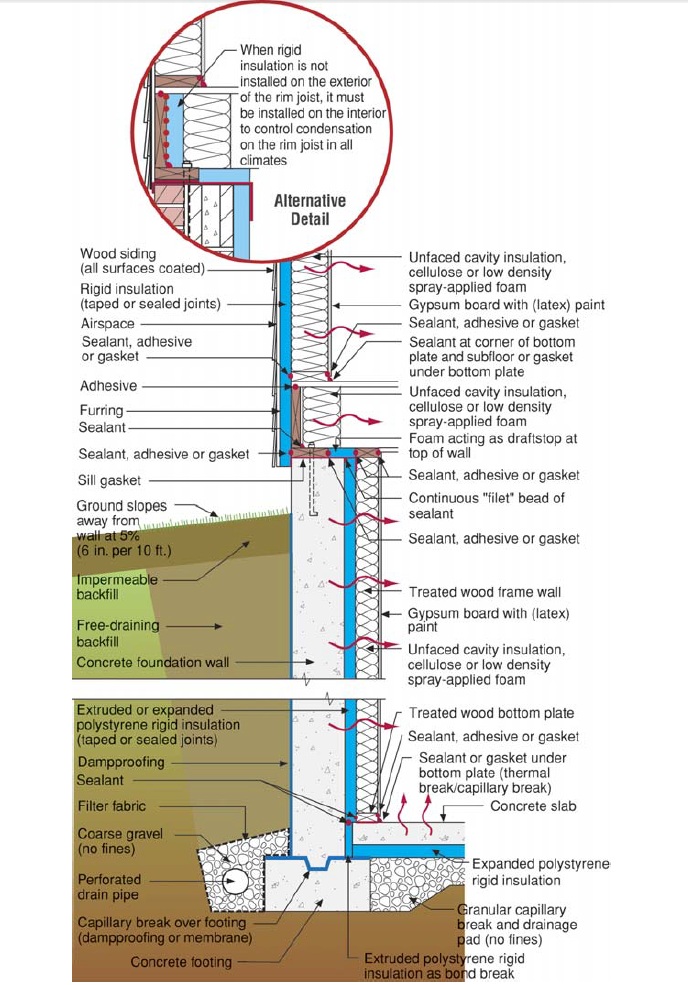Exploring the Different Techniques and Solutions for Effective Damp Proofing
Moisture in buildings presents considerable obstacles to both architectural honesty and indoor air high quality. Different strategies and remedies have emerged to fight this prevalent concern. From conventional damp-proof membranes to innovative chemical treatments, each method offers unique benefits. Understanding these options is necessary for reliable dampness control. However, choosing the right solution depends on specific building conditions and needs, prompting further exploration into one of the most reliable moist proofing methods readily available.
Understanding the Root Causes Of Dampness
Although dampness can emerge from various sources, understanding these reasons is crucial for effective removal. Generally, wetness originates from three key resources: rising moist, passing through wet, and condensation. Rising moist occurs when groundwater travels up with porous materials, such as block or stone, frequently as a result of a lack of an effective barrier (damp proofing newcastle). Passing through wet is commonly triggered by exterior elements, consisting of roof leaks, damaged gutters, or damaged wall surfaces, permitting water to infiltrate a property. Condensation, on the other hand, arises from excess dampness in the air, typically worsened by poor ventilation and temperature level differences, causing water beads developing on surfaces. Determining these underlying issues is necessary, as each type of moisture calls for a customized method for removal. Correct analysis helps in figuring out one of the most effective options, inevitably protecting the architectural honesty of a building and enhancing indoor air high quality
Standard Damp-Proof Membrane Layers

Chemical Damp-Proofing Solutions
Chemical damp-proofing solutions provide an innovative method to stop wetness invasion in buildings. These techniques normally involve the application of liquid chemicals that penetrate stonework and create an obstacle against increasing damp. Commonly made use of chemicals include silanes, siloxanes, and other water-repellent agents that respond with surface area products to create a hydrophobic layer.The application process usually calls for drilling holes right into the wall surfaces, injecting the chemical solution, and permitting it to heal. This technique is particularly advantageous for older structures where typical damp-proof membrane layers might be impractical. Furthermore, chemical damp-proofing can be much less turbulent and much more cost-effective than extensive restoration projects.While effective, these remedies depend upon proper application and ecological conditions for peak performance. Regular maintenance and tracking are important to assure the durability of the damp-proofing treatment. Generally, chemical damp-proofing represents a functional choice for securing buildings against moisture-related damage
Cavity Wall Construction Methods
Cavity wall building techniques supply various benefits, particularly in moisture control and energy efficiency. By including an air void between 2 layers of stonework, these walls properly reduce water access while enhancing insulation. This combination not only secures frameworks from dampness but likewise adds to minimized power intake.
Benefits of Cavity Walls
When taking into consideration reliable damp proofing approaches, the advantages of cavity walls stick out prominently. Cavity walls consist of two separate layers, producing an air gap that properly decreases wetness penetration. This layout reduces the risk of moisture, as the outer wall functions as an obstacle versus rain and water ingress. Additionally, cavity walls enhance thermal insulation, which contributes to energy efficiency by reducing heat loss. They also provide audio insulation, assisting to create a quieter indoor setting. The air gap allows for air flow, which assists in wetness control and decreases the possibility of mold development. These advantages not just enhance the general comfort of a structure however likewise add to its durability and structural honesty.
Dampness Control Approaches
Efficient dampness control techniques are essential in dental caries wall construction to ensure long-term security against moisture. One key method includes the unification of weep holes, which facilitate water drain from the dental caries, avoiding buildup. Additionally, making use of breathable membrane layers can help handle dampness levels while allowing entraped vapor to get away. Correct placement of insulation is likewise vital, as it should not block drain paths. Furthermore, guaranteeing that the outer leaves of the dental caries wall are built with waterproof products boosts total sturdiness. Regular upkeep checks are vital to recognize any blockages or damage early, securing the structure's honesty. Inevitably, a mix of these strategies creates a robust protection versus dampness breach in dental caries wall surfaces.
Insulation and Power Performance
Insulation plays a vital role in enhancing energy efficiency within cavity wall surface construction. By incorporating insulating materials, these wall surfaces develop a thermal obstacle that lessens warmth loss and lowers power usage. Effective insulation not only helps maintain a secure interior temperature level however also mitigates the risk of wetness, as it protects against condensation within the wall surface dental caries. Different methods, such as using inflexible foam boards or mineral woollen, can be utilized to achieve perfect insulation performance. In addition, proper installment is vital to ensure that voids and spaces are reduced, which can or else compromise power effectiveness. Ultimately, a well-insulated dental caries wall adds substantially to general sustainability and decreases cooling and heating expenses for homeowners.
Exterior Damp Proofing Techniques
External wet proofing techniques are essential for shielding structures from dampness infiltration. 2 efficient techniques consist of the application of water resistant membranes and the setup of French drains. These options help minimize water accumulation and maintain the stability of buildings.
Waterproof Membrane Application
While different approaches exist for avoiding wetness access, the application of waterproof membranes continues to be a highly effective outside moist proofing technique. These membrane layers are usually made from products such as polyethylene, rubber, or changed asphalt, providing a robust barrier against water infiltration. The installment process involves applying the membrane to the outside surface areas of wall surfaces or structures, ensuring total coverage to stop leakages. Appropriate adhesion and sealing at joints are crucial to making best use of effectiveness. Water resistant membrane layers can be applied in different forms, including liquid finishes and sheet membranes, permitting versatility based upon the particular demands of the structure. This method not only protects buildings from wetness yet likewise boosts their longevity and structural honesty.
French Drainpipe Setup
One efficient technique for handling groundwater here and protecting against dampness accumulation around a building's structure is the installment of a French drainpipe. This water drainage system is composed of a trench loaded with crushed rock and a perforated pipe that redirects surface area water away from the foundation. Appropriate installment needs careful preparation, ensuring that the drain inclines far from the structure to help with optimal water flow. Additionally, the location of the drainpipe is crucial; it needs to be placed in areas prone to merging or excess wetness. Routine maintenance, consisting of cleaning debris from the crushed rock and making certain the pipeline continues to be unblocked, is vital for long-term effectiveness. Inevitably, a well-installed French drain can greatly lower the danger of water-related concerns in basements and structures.
Interior Waterproofing Methods
Interior waterproofing methods are vital for securing a structure's interior from dampness infiltration and possible water damage. These methods typically include the application of customized materials and methods designed to produce a dampness barrier within the structure. One common technique is the use of water resistant coverings or sealers on walls and floors, which protect against moisture from permeating surfaces.Additionally, mounting indoor water drainage systems, such as sump pumps, can efficiently manage water accumulation in cellars and creep rooms. Another method entails the usage of vapor obstacles, which are set up to prevent moisture activity from the ground into living spaces.Moreover, resolving any kind of fractures or spaces in wall surfaces or foundations with suitable sealants assures a thorough protection against water intrusion. By carrying out these indoor waterproofing approaches, residential property proprietors can greatly decrease the danger of mold and mildew growth, architectural damages, and various other moisture-related problems. Appropriate execution of these methods is necessary for long-lasting security and building integrity.
Normal Maintenance and Evaluation Practices
Normal maintenance and evaluation techniques are crucial for ensuring the long-lasting efficiency of wet proofing options in any type of building. Routine checks make it possible for residential or commercial property owners to identify very early signs of dampness invasion, such as peeling paint, mold and mildew development, and moldy odors. These indications can indicate underlying issues that call for instant attention.Inspections must be performed at the very least every year, concentrating on prone areas like basements, creep areas, and exterior walls. Throughout these analyses, homeowner need to examine sealers, drainage systems, and ventilation to validate they function correctly.Additionally, keeping downspouts and seamless gutters is essential, as stopped up systems can result in water accumulation near the structure. Carrying out a regular upkeep routine, along with prompt repairs, can substantially prolong the life expectancy of damp proofing actions and secure the structural stability of the building. Aggressive steps inevitably add to the general health and wellness of the living setting.
Often Asked Questions
For How Long Does Damp Proofing Normally Last?
The duration of damp proofing effectiveness varies, generally lasting in between 20 to 50 years. Elements such as application high quality, ecological problems, and upkeep practices greatly influence the long life of the damp proofing treatment.

Can I Damp Evidence My Home Myself?
The individual pondered the expediency of do it yourself damp proofing. With proper study and the best products, it is possible. They also acknowledged the value of expert advice to assure resilient performance and stop future concerns.
What Are the Signs of Ineffective Damp Proofing?
Indications of ineffective damp proofing include consistent mildewy smells, noticeable mold growth, peeling paint, damp patches on walls, and timber degeneration - damp proofing newcastle. Homeowners need to resolve these concerns immediately to avoid additional damage and health and wellness problems
Does Damp Proofing Affect Indoor Air Quality?

Exactly How Much Does Specialist Damp Proofing Cost?
Expert wet proofing costs vary substantially, generally varying from $1,000 to $5,000 depending on the residential property's size, the degree of the damp concern, and selected techniques. Each circumstance needs a customized evaluation for accurate rates. Typically, dampness stems from three key sources: climbing moist, penetrating wet, and condensation. When thinking about reliable moist proofing methods, the advantages of cavity walls stand out plainly. Outside wet proofing techniques are crucial for securing structures from dampness infiltration. While different approaches exist for preventing moisture ingress, the application of waterproof membranes remains a highly effective external damp proofing technique. Signs of inefficient moist proofing include relentless musty smells, noticeable mold and mildew growth, peeling paint, moist patches on wall surfaces, and wood degeneration.